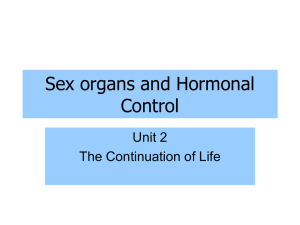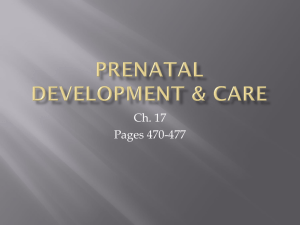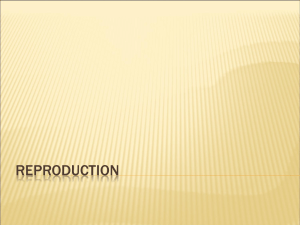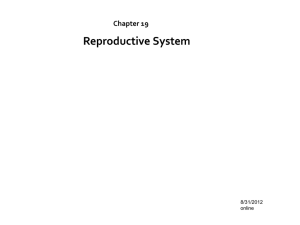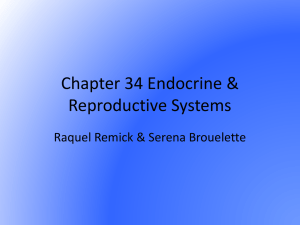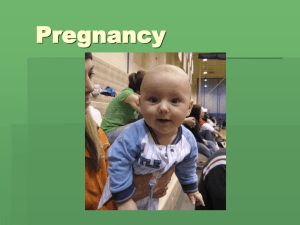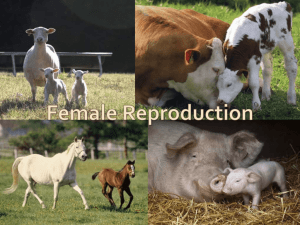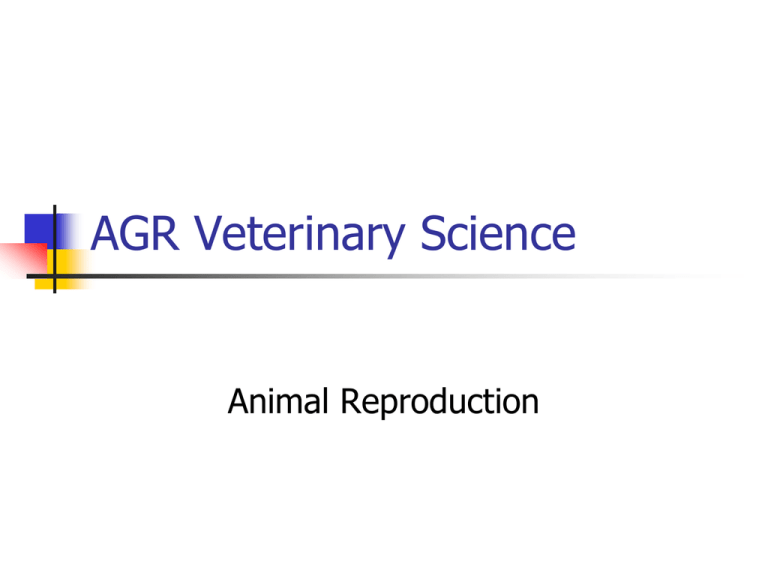
AGR Veterinary Science
Animal Reproduction
Objectives
Be able to properly List the male and
female reproductive tracts
Describe the functions of each of the
parts of the reproductive tracts.
Properly describe the processes of
reproduction starting with the
hormones
Cow Reproductive Tract
Ovary
Infundibulum
Oviduct
Uterine horn
Uterus
Cervix
Vagina
Vulva
Canine Female Repro Tract
Sow Reproductive Tract
Bull Reproductive Tract
Testis
Epididymis
Vas deferens
Seminal vesicles
Prostate
Cowper’s gland
Urethra
Penis
Boar Reproductive Tract
Repro Basics
Coordinated effort between the endocrine
system and the reproductive physiology
and anatomic body parts of the male and
female.
Coordination consists of: germ cell
development and maintenance,
fertilization of egg by sperm, pregnancy,
and parturition.
Reproduction Endocrinology
Hypothalamus gland begins the reproductive
endocrinology.
Located at the base of the brain.
Releases gonadotropin releasing hormone (GnRH).
GnRH is released in a pulsating manner to the
anterior pituitary gland.
GnRh release is triggered by environmental factors, i.e.
night length, temperature, presence of the opposite
sex.
Anterior Pituitary Gland
Located just below the
hypothalamus gland.
Receives GnRH and responds
by releasing
Luteinizing hormone (LH)
Follicle-stimulating hormone
(FSH)
LH and FSH enter the blood
stream and travel to the testes
(male) and ovary (female) all so
in a pulsating manner.
Testosterone
Male sex hormone produced by the testes.
LH provides the testes the signal to produce
testosterone.
Testosterone is necessary for the
production of the secondary sex
characteristics in the male.
Sperm production is a function of the testes
as a result of the influence of the FSH.
Ovary Activity
FSH is responsible for the
growth and maintenance of
the follicle on the ovary.
Singular birth, twins or
triples, and multiple births
like litters are a result of the
development of one or more
follicles specific to different
species.
Estrogen
Estrogen is produced by
the follicle.
Estrogen surge stimulates
the pituitary gland to release
LH which leads to the
breakdown of the follicle wall
and an ova (egg) is expelled
from the follicle.
The process of ova being
released from the follicle is
called ovulation.
Ovulation
The released ova is
captured or caught by
the infundibulum of
the reproductive tract.
The infundibulum
directs the egg into the
oviduct of the tract.
The top is of a cow and
the lower is of a sow.
Hormonal Activity After
Ovulation
The follicle after ovulation
turns into a corpus luteum
(CL).
Appears or feels like a hollowed
cavity on the surface of the
follicle on the ovary.
Early pregnancy checking by
palpation in larger animals
involves checking for the CL on
the ovary.
CL produces the hormone,
progesterone.
Progesterone
Progesterone from the CL is the pregnancy
maintenance hormone during early pregnancy
(cow, mare, ewe). Required by goats, rabbits and
sows throughout pregnancy.
Inhibits the release of LH and FSH.
Prevents the estrus signs.
Placenta provides progesterone to maintain
pregnancy during the later stages of pregnancy.
Placenta surrounds the fetus and is attached to
the uterine wall of the female.
Oxygen and nutrients pass to the fetus from the
female with waste passing to the female
Hormonal Activity During the
Estrus Cycle
The Estrus Cycle
Length of the estrus cycle is species specific
Cattle 18 – 24 days
Swine 18 – 24 days
Sheep 14 – 20 days
Horses 16 – 30 days
Goats 15 – 24 days
Dogs 3 ½ - 13 months
Cats 14 – 21 days
Length of Estrus
Estrus by species
Cattle – 14 hrs
Swine – 2-3 days
Sheep – 30-35 hrs
Horses – 6 days
Goats – 42 hrs
Dogs – 6-12 days
Cats – 6-7 days
Timing of Ovulation Compared
To Signs of Estrus (Heat)
Timing by species
Cattle - 10-14 hrs after end
Swine - 18-60 after beginning
Sheep - 1 hr before the end
Horses - 1-2 days before the end
Goats - near the end
Dogs - 1-3 days after acceptance of male
Cats - Stimulated by mating
Signs of Estrus By Females
Stands to be mounted
Frequent urination
General nervousness
Anatomy of the Female Tract
Ovaries
Occurs in pairs
Responsible for the storage, development, and release of ova.
Produces progesterone and estrogen
Produces multiple follicles each estrus cycle from which one or
more develop to ova depending on the species. LH responsible for
release of ova.
Infundibulum
Thin funnel shaped membrane which captures the expelled ova
from the ovary.
Prevents the ova from entering the abdominal cavity and directs
the ova into the oviduct.
Anatomy Cont’d
Oviducts or Fallopian Tubes
The three sections of the oviduct
Infundibulum
Ampulla
Isthmus
Site of the fertilization of the ova by the sperm cell.
Most fertilization occurs in the ampulla.
The oviduct provides nutrients and a transportation
medium from the secretions for the ova.
Eggs remain in the oviduct from 3-6 days.
Anatomy Cont’d
Uterine horns and uterus
Shape and configuration from oviduct to uterus differs
between species.
Uterus provides a passageway up and through for
sperm cells swimming up the tract.
Provides glandular secretions for the embryo prior to
implantation into the uterine wall and formation of the
placenta lining the wall.
Provides for the elimination of waste products from the
developing fetus.
Through muscular contractions of the uterus during
parturition, the fetus is expelled from the female.
Anatomy of the Uterus Cont’d
A corpus luteum (CL)is formed from the
follicle which expels the egg. The CL
produces progesterone to reduces
contraction of the uterus which allows
for the embryo to attach itself to the
thickening placenta along the uterine
wall.
Anatomy Cont’d
The cervix is the intermediary structure between
the uterus and vagina.
5 primary functions
A passageway for sperm cells
Serves as a storage reservoir for sperm cells for a
uniform distribution over time into the uterus.
Serves as a primary barrier (a mucus plug or cervical
plug is formed) between external and internal
environments.
To provide lubrication through secretions which in turn
flush the vagina of contaminants.
Serves as a passageway for the fetus during parturition.
Anatomy Cont’d
Vagina
Main copulatory organ of most species (swine are
excluded).
Has a well developed mucus layer.
Connects cervix to vulva
Vulva
Exterior organ to the female tract.
Appearance is an indicator of extrus or the onset of
parturition.
Anatomy of the Male Tract
Testes
Counter structure in the male versus the ovaries in the
female.
Produces sperm cells and testosterone.
Held in place by the spermatic cord within the scrotum.
Maintains the temperature of the testes 4-6 degree’s C below
body temp.
Contracts and expands to warm or cool.
Contains the blood vesscles
Anatomy of Male Cont’d
Sperm cells are continuously produced by the
seminiferous tubules of the testes.
Sperm migrate to the epididymis for
development (maturation), storage, and
transport.
The most mature sperm are found in the tail of
the epididymis as opposed to the head.
Prior to ejaculation, sperm cells move out of the
epididymis to the vas deferens and the
urethra.
Anatomy of the Male Cont’d
Sperm cells are suspended in fluid from the
testes, but the semen portion of the
ejaculate is provided by 3 secondary sex
glands.
Seminal vesicles
Prostate
Bulbourethral glands (Cowpers gland)
Anatomy of the Male Cont’d
Secondary sex glands:
Produce the volume of the semen
Add nutrients
Provide cleansing agents for the urethra
Aid in coagulation of the semen after ejaculation
Produce a gelatinous fraction which seals the
cervix after breeding to prevent semen loss
through the vagina.
Anatomy of the Male Cont’d
Penis
Vascular (enlarges during sexual excitement by
retaining blood in the erectile tissue.
Erections occur due to increased blood volume under high
pressure.
Following ejaculation, blood leaves the organ and the erection
subsides.
Horses are example of a vascular penis.
Fibroelastic (penis exists in a S-shaped configuration
inside the body cavity until sexual excitement)
Sigmoid flexure muscle extends the penis
Retractor muscle is responsible for returning penis to the body
cavity.
Bulls, boars, and rams have a fibroelastic penis’
Pregnancy or Gestation
Zygotes are formed from the union of sperm cell
and egg cell.
Embryos are formed when zygotes begin to carry
on mitosis or cell replication.
Embryo implantation into the uterine wall lining or
the placenta 14 to 40 days after fertilization.
2/3 of fetal growth takes place in the last 1/3 of
gestation.
Hormonal Activity of Pregnancy
Corpus luteum supplies large amounts
of progesterone to maintain the
pregnancy.
Progesterone from the placenta
prevents the degradation of the CL.
Fetal Membranes of the
Placenta
Amnion
Chorion & allantois
Contains a fluid which protects and cushions the
fetus.
In contact with the endometrium of the uterus.
Yolk sac
Nutrients to the embryo and early fetus.
Activities of the Placenta
Regulates the exchange of oxygen
Nutrients to the fetus
Waste materials away from the fetus
Antibodies between the fetus and
mother
More connection between placenta and
uterus in ruminants than swine
Gestation Rates in Days
Cattle – 283
Swine – 113
Sheep – 150
Horses – 336
Goats – 151
Dogs – 63
Parturition or Birth
Initiated by hormones secreted by the offspring.
Oxytocin from the posterior pituitary gland
travels to the muscles of the uterus to cause
contractions.
Pressure against the cervix will neurologically
message the pituitary.
Fluids from the fetal membranes will lubricate the
cervix and vagina for ease of offspring passage.
The final phase of parturition is the expulsion of
the fetal membranes or afterbirth.


